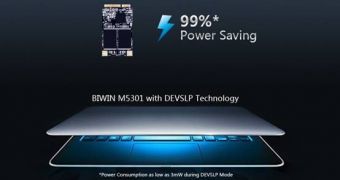It isn't every day that someone can claim a solid-state drive can operate on 1% of the normal amount of energy needed, but that is precisely what BIWIN says about the business-grade SSD M5301.
The drive can't actually function normally on that little energy. If it could, it would be like announcing that a source of free energy has been successfully created.
What BIWIN managed to do was enable the newcomer to enter something called the DEVSLP mode.
In that mode, hosts and devices can completely shut down the SATA interface, saving a lot of energy compared to normal idle modes (Partial and Slumber power states).
Simply because those states need the physical layer to be left powered, and that always drains energy.
Thus, ultrabooks and tablets, and any other mobile or entertainment devices, will benefit from considerably longer battery charges.
For those who want numbers, the DEVSLP state of the BIWIN SSD M5301 cuts the power draw to 3 mW.
That's well below the 5 mW that Intel sought back in 2012, when it outlined a new specification for low-power SSDs.
That's 99% below the 300 mW of normal mSATA drives. And since 300 mW is already quite little, we can safely say that the BIWIN drive basically eats no power at all unless something is being written or read from it.
Which doesn't happen while, say, a game with levels is playing, save for when rounds are completed and a new stage has to be loaded.
Web browsing, likewise, should put no strain on the storage once the browser has been fully loaded.
BIWIN will formally launch the SSD M5301 at the Computex Taipei trade show next week, June 4-8, 2013. Sadly, we'll have to wait until then to learn the capacities, performance and corresponding price tags.

 14 DAY TRIAL //
14 DAY TRIAL //